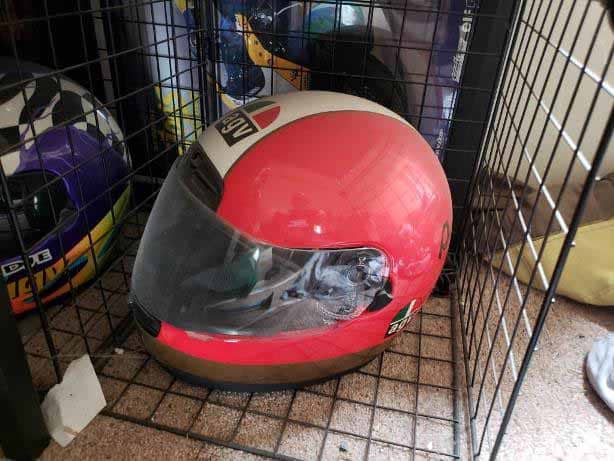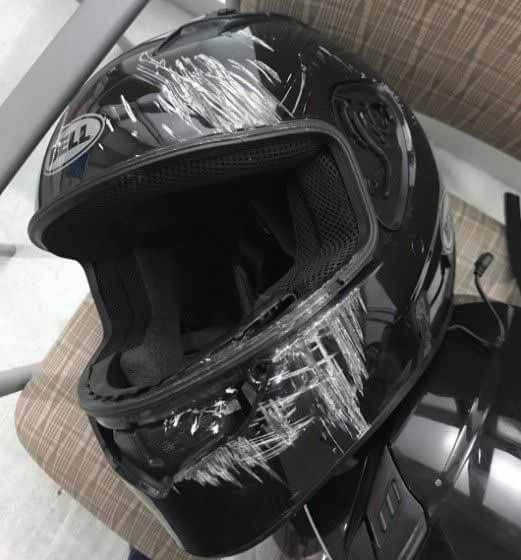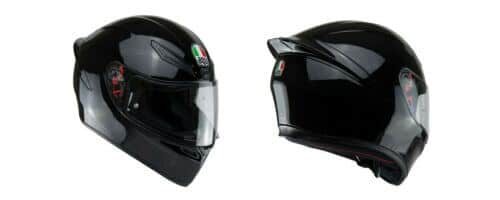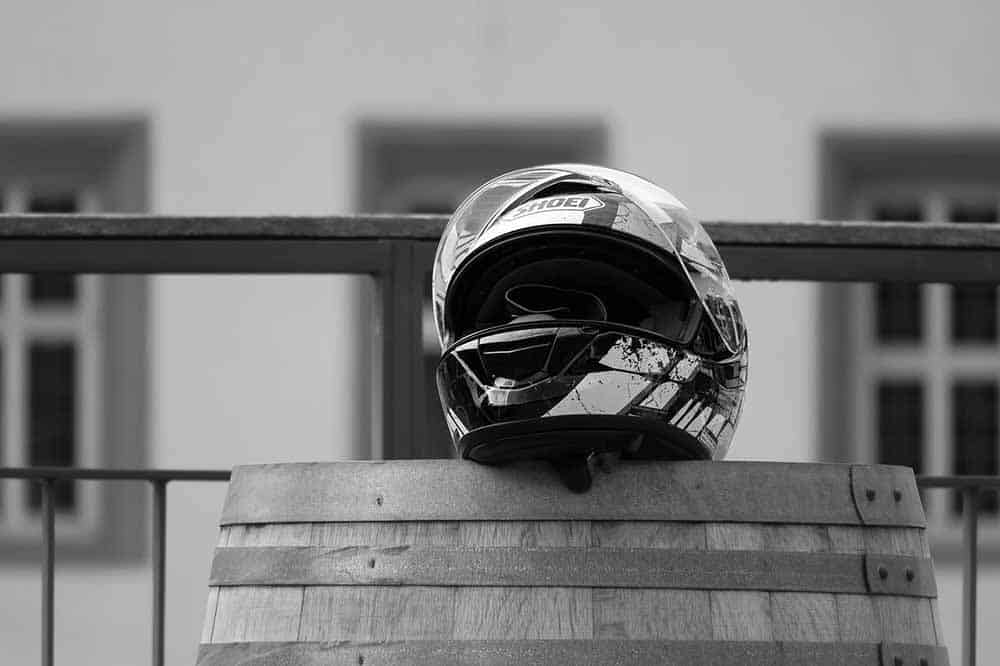You’re wondering when to replace your motorcycle helmets? It’s important not to cut corners. Your helmet is one piece of motorcycle safety gear that you don’t want to skimp on. So, when should you replace the motorcycle helmet?
You should replace your motorcycle helmet at least every five years if it has not been subject to a crash or any other type of damage. However, the US Consumer Product Safety Commission recommends changing helmets within 5 to 10 years.
But if you want the best protection for your head, the range is just a general guideline. You need to know every factor that influences your safety.
A helmet isn’t just a simple replacement – there are factors you must consider. This post explains when to replace a motorcycle helmet and what signs to look out for. So read on and be sure to keep your head protected while riding!
When To Replace Motorcycle Helmet
You should replace your motorcycle helmet if it’s past its expiry date, has a crash, or doesn’t fit you anymore. Other signs of when to replace a motorcycle helmet include natural wear and tear and simply being dirty, smelly, or worn out. Or your dog may have used it as a chew toy.
Are you wondering when to replace your motorcycle helmet? Well, the timeframes depend on the type of helmet, how often it is used, and how well you take care of it. This section expounds on some of the factors that can contribute to needing a new helmet sooner.
Reports indicate that if all motorcyclists would have worn helmets in 2016, helmets could have saved 806 of the total lives lost.
Expiry Date
If you’re wondering when to replace your motorcycle helmets, check the expiry date. But do helmets expire? Yes, helmets have an expiry date that counts from the manufacturing date. Depending on the brand, a helmet’s lifespan can be between 3 to 5 years. Composite helmets, those with shells made of materials like fiberglass, carbon fiber, Kevlar, Dyneema, etc. tend to last longer than Thermoplastic shell helmets made from materials like ABS and Polycarbonate. Thermoplastic shells are more prone to degradation by long exposure to sunlight and some chemicals.
However, it is essential to note that the lifespan varies depending on the care. For instance, exposure to different weather conditions affects the lifespan of a motorcycle.
After A Crash/Accident
Any time you are involved in a crash or accident when the helmet suffers an impact it is time to replace the motorcycle helmet. You don’t have to see any visible signs of damage as the most serious damage is likely to be internal in the EPS (expanded polystyrene) liner.
So why do you need to replace your helmet if you have an accident? Usually, the impact can weaken or destroy the helmet’s shell or liner material, which decreases its ability to protect you in future accidents. Therefore, even if your helmet looks fine outside, it might not offer the same level of protection as a new one.
You May Like: Snell vs DOT Motorcycle Safety Helmet Standard-Which is better?
Fit
As you wear your helmet over time, it will naturally loosen up. The loosening is due to both the materials stretching and your hair and skin oils breaking down the helmet’s interior. Similarly, the helmet may be tight if you increase your diet or gain weight over time.
Whether the helmet is tight or loose, you’ll want to replace it. A properly fitting helmet should be snug and cozy. You should be able to fit no more than two fingers between the strap and chin. Otherwise, it’s too tight or loose for you. You don’t want to get a headache from a helmet being too tight but being too loose is even a worse problem as it is dangerous and increases the likelihood of the helmet coming off in the event of a fall.
When it Falls
One of the best times to replace motorcycle helmets is when they fall from a considerable height. For example, on a bookshelf, off the top of a truck, or on a ledge or roof. A fall can cause severe damage, even if the helmet doesn’t hit anything hard but the floor. And the fall doesn’t have to be from extreme heights; 2 meters is enough to seek a replacement.
However, there may be exceptions to the free fall factor. For example, the fall will be less catastrophic if the helmet accidentally drops on a cushioned surface. But if the helmet fell on a hard surface, there is a possibility it generated enough force to cause damage.
Natural Wear and Tear
Over time, your helmet will succumb to wear and tear. The outer shell of a thermoplastic helmet will degrade due to the sun’s UV rays, causing them to weaken and break down. Humidity and heat can also cause the helmet to lose shape, become brittle, and ultimately crack.
On the other hand, the inner sponge and cushioning will also break down and lose their suppleness. This breakdown usually happens within the 3–5-year period. Together, these factors will affect the helmet’s ability to protect your head in the event of an accident.
Malfunction Components
For the helmet to protect you, all the components must be working correlatively. And if they aren’t, it’s when to replace the motorcycle helmet. Some essential elements that may malfunction include the helmet’s straps and fasteners. The straps become frayed or weak over time, while the pins may become loose or undone.
Malfunctioning can be catastrophic during an accident. For example, if the straps aren’t in place, the helmet can fly off or not stay in place during an accident, exposing your head to serious injury. If the face shield is cracked or scratched, it won’t be able to protect your eyes from debris in the event of an accident.
Factors To Consider When Buying a Motorcycle Helmet Replacement
When buying a replacement motorcycle helmet, you should consider your riding environment. Other issues include how often you ride and the type of riding factor.
There is no absolute rule of thumb on when to replace a motorcycle helmet. There is no one-size-fits-all answer to replacement. Just like with anything else, the right time depends on a variety of factors. Always err on the conservative side as it is better to be safe than sorry later.
You May like: The Safety of Full-Face Helmets
1. How Often Do You Ride?
If you only ride occasionally, you can probably get away with replacing your helmet every five years or so. However, if you’re a regular rider, you’ll want to replace your helmet more often.
If you are riding in mild temperate weather the helmet will last longer than if you are riding a lot in hot and humid weather.
Regular motorcycle riders should replace their helmets within about three to five years. However, the US Consumer Product Safety Commission recommends changing helmets within 5 to 10 years. The commission also recommends replacing it depending on the frequency of use, among other factors. Frequency of use and other factors can significantly shorten the life of your helmet so please be familiar with them.
2. What Type of Riding Do You Do?
The type of riding activities you do dictates when to replace your motorcycle helmet. For example, if you do a lot of off-road riding, you’ll need to replace your helmet more often than if you stick to paved roads. Off-road riding is more vigorous and likely to cause wear and tear on your helmet.
Additionally, the riding activities expose the helmet to different environments and harshness. For example, a dirt motorcycle rider will expose his helmet to more hardcore activities than a street biker. Off-road riders are likely to have many more falls and subject the helmet to numerous impacts even if small. Therefore, be keen on how engaging your activity is and replace the helmet when necessary.
3. What Conditions Do You Typically Ride In?
If you live in an area with extreme weather conditions, you may need to replace your helmet more often than in a milder climate. Severe weather conditions cause more damage to your helmet.
For example, the sun can cause the helmet’s shell materials to break down over time. Fading of the visor due to sun UV light could cloud your clarity. Additionally, riding in cold weather can cause a helmet with a thermoplastic shell to become brittle and more susceptible to damage.
4. How Well Do You Take Care of Your Gear?
If you take good care of your motorcycle safety helmet, it will last longer. Rule of thumb; the frequency of when to replace a motorcycle helmet reduces if you maintain your gear. Be sure to clean and inspect your helmet regularly and store it properly when you’re not using it. For example, a cool, dry, chemical-free environment.
Additionally, sweating excessively and not drying the helmet liner after each use degrades the helmet. You should also not store the helmet in a humid environment. All these factors can shorten the lifespan of your helmet, so be sure to take good care of it if you want it to last or replace it once in a while.
So, are you wondering when to replace your motorcycle helmet? The answer may vary depending on your circumstances, but the above general guidelines can help you make the best decision for your needs.
FAQ
1. How Do You Tell If a Motorcycle Helmet Is Expired?
You can tell if a motorcycle helmet is expired by looking at the manufacturing date. The date is usually stamped on the helmet, or a sticker used on the helmet. The helmet has expired if the date is more than five years old.
2. Can You Sell Second-Hand Motorbike Helmets?
Yes, you can sell a second-hand motorcycle helmet. However, it is not recommended as you do not know the history of the helmet and may have purchased a helmet with less protective abilities. It would not be wise to risk your life to save a few dollars. For example, if the helmet was involved in an accident, there is internal damage that you cannot see, and it is no longer safe to use and must be replaced. Also, the selling of second-hand motorcycle helmets is illegal in some countries.
3. Do Helmets Actually Expire?
Yes, motorcycle helmets do have an expiration date. When to replace a motorcycle helmet varies with the type of helmet and how often you use it. Manufacturers typically recommend replacing your helmet every five years.
Final Thoughts
Motorcycle helmets should be replaced at least every five years or after a crash, or after exposure to harsh chemicals such as solvents, whichever comes first. Helmet replacement is important for rider safety and reduces injuries in the event of an accident.
We hope the article has cleared up any doubts you have on when to replace motorcycle helmets. However, if you are unsure whether your helmet needs to be replaced, please consult a professional. Helmets are critical to motorcycle safety, so they must always be in good operating condition.
Information for this article was partially sourced and researched from the following authoritative Government, educational, corporate, and nonprofit organizations:
US Consumer Product Safety Commission
Which Helmet for which activity: USA
FM/Ir







